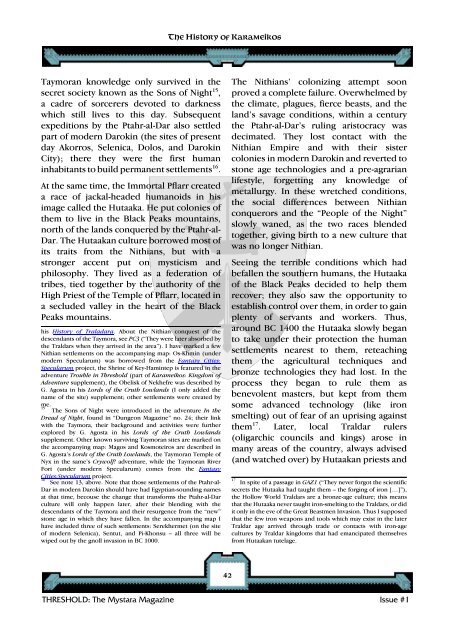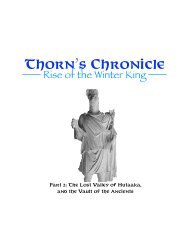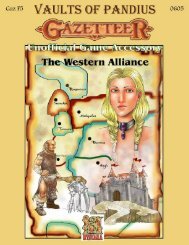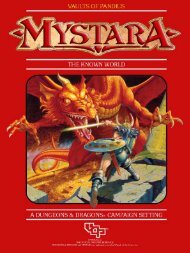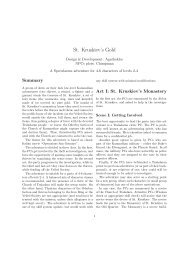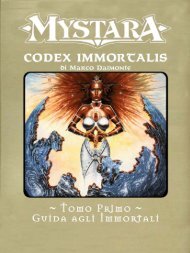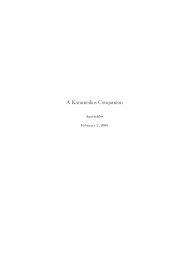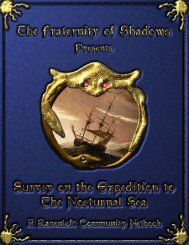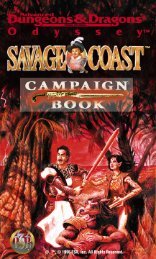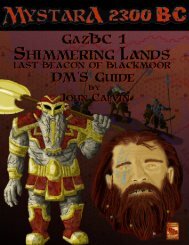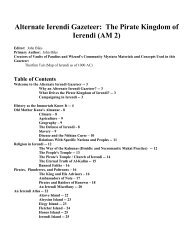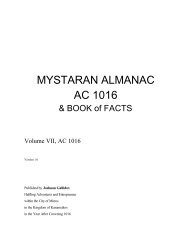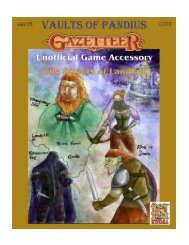Karameikos - Vaults of Pandius
Karameikos - Vaults of Pandius
Karameikos - Vaults of Pandius
You also want an ePaper? Increase the reach of your titles
YUMPU automatically turns print PDFs into web optimized ePapers that Google loves.
The History <strong>of</strong> <strong>Karameikos</strong>Taymoran knowledge only survived in thesecret society known as the Sons <strong>of</strong> Night 15 ,a cadre <strong>of</strong> sorcerers devoted to darknesswhich still lives to this day. Subsequentexpeditions by the Ptahr-al-Dar also settledpart <strong>of</strong> modern Darokin (the sites <strong>of</strong> presentday Akorros, Selenica, Dolos, and DarokinCity); there they were the first humaninhabitants to build permanent settlements 16 .At the same time, the Immortal Pflarr createda race <strong>of</strong> jackal-headed humanoids in hisimage called the Hutaaka. He put colonies <strong>of</strong>them to live in the Black Peaks mountains,north <strong>of</strong> the lands conquered by the Ptahr-al-Dar. The Hutaakan culture borrowed most <strong>of</strong>its traits from the Nithians, but with astronger accent put on mysticism andphilosophy. They lived as a federation <strong>of</strong>tribes, tied together by the authority <strong>of</strong> theHigh Priest <strong>of</strong> the Temple <strong>of</strong> Pflarr, located ina secluded valley in the heart <strong>of</strong> the BlackPeaks mountains.his History <strong>of</strong> Traladara. About the Nithian conquest <strong>of</strong> thedescendants <strong>of</strong> the Taymora, see PC3 (“They were later absorbed bythe Traldars when they arrived in the area”). I have marked a fewNithian settlements on the accompanying map: Os-Khmin (undermodern Specularum) was borrowed from the Fantasy Cities:Specularum project, the Shrine <strong>of</strong> Key-Hamintep is featured in theadventure Trouble in Threshold (part <strong>of</strong> <strong>Karameikos</strong>: Kingdom <strong>of</strong>Adventure supplement), the Obelisk <strong>of</strong> Nekhefre was described byG. Agosta in his Lords <strong>of</strong> the Cruth Lowlands (I only added thename <strong>of</strong> the site) supplement; other settlements were created byme.15The Sons <strong>of</strong> Night were introduced in the adventure In theDread <strong>of</strong> Night, found in “Dungeon Magazine” no. 24; their linkwith the Taymora, their background and activities were furtherexplored by G. Agosta in his Lords <strong>of</strong> the Cruth Lowlandssupplement. Other known surviving Taymoran sites are marked onthe accompanying map: Magos and Kosmoteiros are described inG. Agosta’s Lords <strong>of</strong> the Cruth Lowlands, the Taymoran Temple <strong>of</strong>Nyx in the same’s Crywolf! adventure, while the Taymoran RiverFort (under modern Specularum) comes from the FantasyCities:Specularum project.16See note 13, above. Note that those settlements <strong>of</strong> the Ptahr-al-Dar in modern Darokin should have had Egyptian-sounding namesat that time, becouse the change that transforms the Ptahr-al-Darculture will only happen later, after their blending with thedescendants <strong>of</strong> the Taymora and their resurgence from the “new”stone age in which they have fallen. In the accompanying map Ihave included three <strong>of</strong> such settlements: Serekhermet (on the site<strong>of</strong> modern Selenica), Sentut, and Pi-Khonsu – all three will bewiped out by the gnoll invasion in BC 1000.The Nithians’ colonizing attempt soonproved a complete failure. Overwhelmed bythe climate, plagues, fierce beasts, and theland’s savage conditions, within a centurythe Ptahr-al-Dar’s ruling aristocracy wasdecimated. They lost contact with theNithian Empire and with their sistercolonies in modern Darokin and reverted tostone age technologies and a pre-agrarianlifestyle, forgetting any knowledge <strong>of</strong>metallurgy. In these wretched conditions,the social differences between Nithianconquerors and the “People <strong>of</strong> the Night”slowly waned, as the two races blendedtogether, giving birth to a new culture thatwas no longer Nithian.Seeing the terrible conditions which hadbefallen the southern humans, the Hutaaka<strong>of</strong> the Black Peaks decided to help themrecover; they also saw the opportunity toestablish control over them, in order to gainplenty <strong>of</strong> servants and workers. Thus,around BC 1400 the Hutaaka slowly beganto take under their protection the humansettlements nearest to them, reteachingthem the agricultural techniques andbronze technologies they had lost. In theprocess they began to rule them asbenevolent masters, but kept from themsome advanced technology (like ironsmelting) out <strong>of</strong> fear <strong>of</strong> an uprising againstthem 17 . Later, local Traldar rulers(oligarchic councils and kings) arose inmany areas <strong>of</strong> the country, always advised(and watched over) by Hutaakan priests and17In spite <strong>of</strong> a passage in GAZ1 (“They never forgot the scientificsecrets the Hutaaka had taught them – the forging <strong>of</strong> iron […]”),the Hollow World Traldars are a bronze-age culture; this meansthat the Hutaaka never taught iron-smelting to the Traldars, or didit only in the eve <strong>of</strong> the Great Beastmen Invasion. Thus I supposedthat the few iron weapons and tools which may exist in the laterTraldar age arrived through trade or contacts with iron-agecultures by Traldar kingdoms that had emancipated themselvesfrom Hutaakan tutelage.42THRESHOLD: The Mystara Magazine Issue #1


